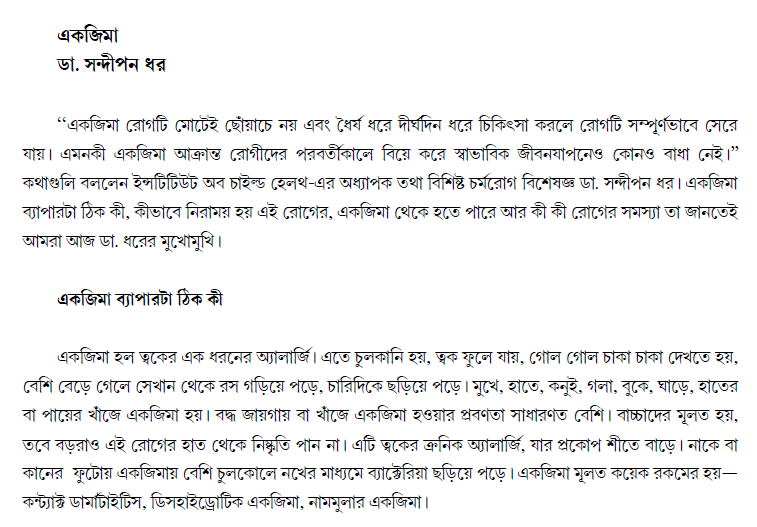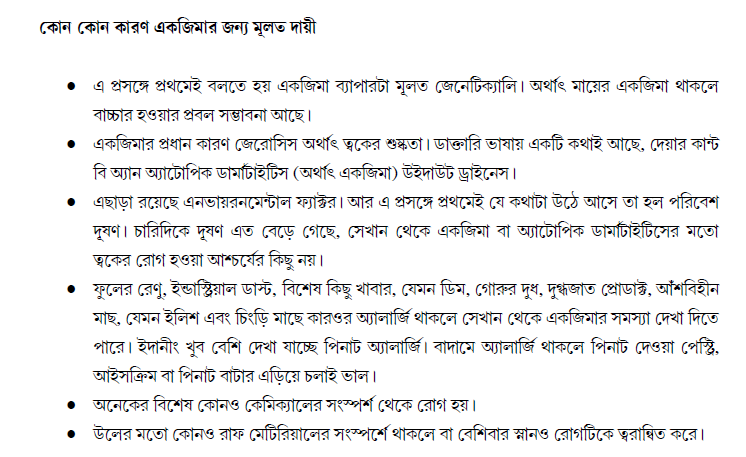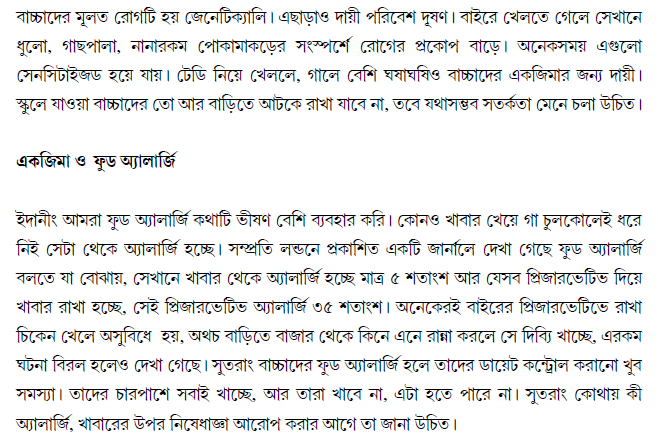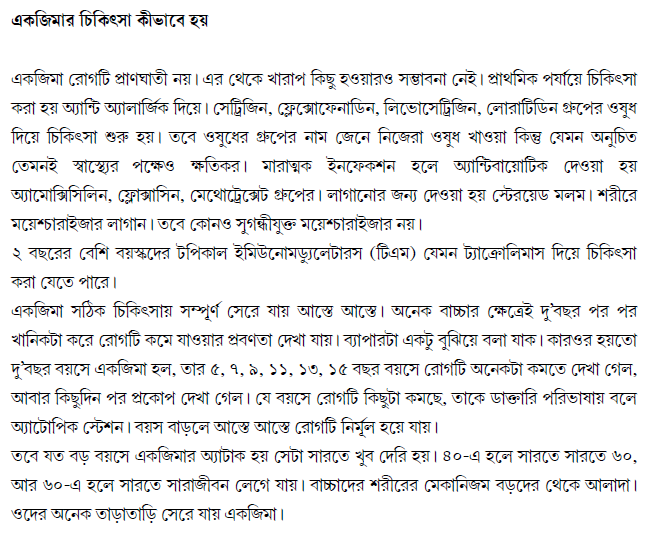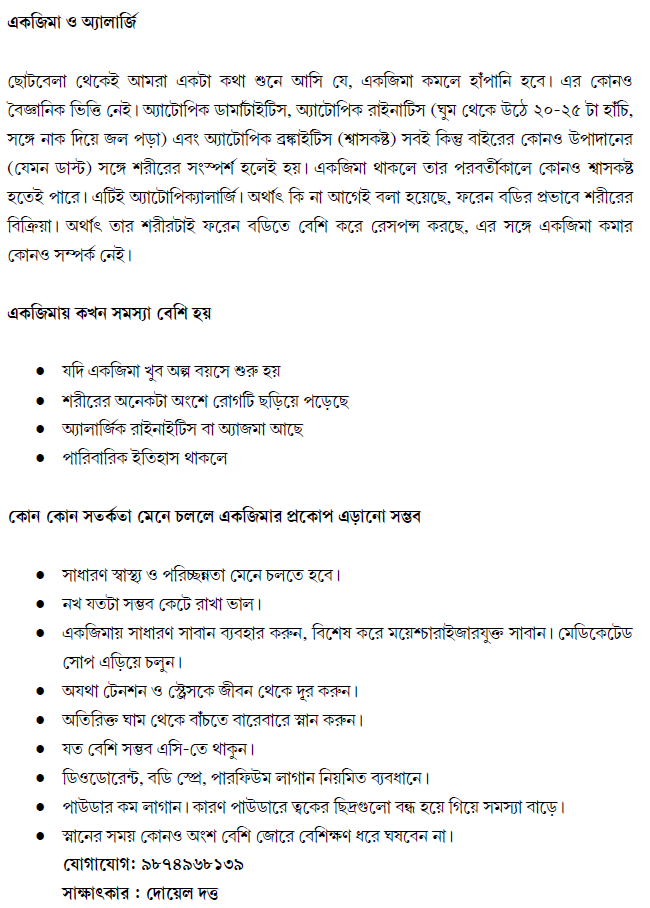FAQ
Frequently Asked Questions
1. What is called latex allergy?
Allergic reaction to latex.
2. Who is usually affected (children/men/women/particular type of worker)?
mostly children. However, adults also can get affected.
3. What are the symptoms?
Itching, redness, oozing and swelling of skin known as angioedema. Secretion or oozing is known as eczema.
4. Types of latex allergy:
two types, allergic contact dermatitis(ACD) and irritant dermatitis(ID)
5. Tests for latex allergy?
Patch test with latex chemical like monobenzyl ether of hydroquinone(MBH), paratertiary butyl phenol(PTBP), paratertiary butyl cathechol(PTBC).
6. Treatment of latex allergy?
Local steroid cream like fluticasone, mometasone, hydrocortisone. Oral antiallergic like fexofenadine, loratadine, cetrizine, levocetrizine etc. In severe cases a short course of oral steroid may be required to control angioedema or severe eczema.
7. Life style and diet?
Local steroid cream like fluticasone, mometasone, hydrocortisone. Oral antiallergic like fexofenadine, loratadine, cetrizine, levocetrizine etc. In severe cases a short course of oral steroid may be required to control angioedema or severe eczema.
1. What is called metal allergy?
Allergic reaction of skin to certain metals like copper,nickel, bronze, iron etc. allergy to silver is rare and allergy to gold is extremely rare.
2. Who is usually affected (children/men/women/particular type of worker)?
Adolescents, young adults and adults. Females much more than males.
3. What are the symptoms?
Itching, redness, oozing and swelling of skin known as angioedema. Secretion or oozing is known as eczema.
4. Types of metal allergy :
two types, allergic contact dermatitis(ACD) and irritant dermatitis(ID)
5. Tests for metal allergy?
Patch test, open use test.
6. Treatment of metal allergy?
Local steroid cream like fluticasone, mometasone, hydrocortisone. Oral antiallergic like fexofenadine, loratadine, cetrizine, levocetrizine etc. In severe cases a short course of oral steroid may be required to control angioedema or severe eczema.
7. Life style and diet?
Those having metal allergy to avoid wearing imitation jewelries. Even the gold earring or ear-top can cause metal allergy because of ear-top push which is always made of copper/bronze.
During summer and rainy season, the relative humidity in atmosphere prevents water evaporation from stratum corneum , the outermost layer of skin. During winter,it is just the otherway round,i.e., there is evaporation of water from epidermis of skin because of very less relative humidity in the atmosphere.The stratum corneum or the outermost layer of skin acts as an epidermal barrier and tries to maintain skin hydration as far as possible.
The commonest problem is aggravation of Atopic Dermatitis, a type of eczema which mostly affects infants and children. Either the child suffers from recurrent sneezing( allergic rhinitis) or bronchial asthma. There may be a history of similar problem in parents, grand parents or siblings. This is a genetically determined skin disease which often runs in families. The basic defect of skin in atopic dermatitis is ‘dry skin’, which in technical term known as ‘xerosis’
Another problem is a skin condition known as ‘ichthyosis’ which is a hereditary skin problem that manifests as fish like scales fixed over skin ( ichthyos in Latin ‘fish’)
The other problem is ‘psoriasis’ where red scaly patches develops over body and there is excessive dry scaling over scalp which is usually labeled as ‘dandruff’.
Children suffering from malnutrition, hypothyroidism or diabetes can have very severe dry skin in winter.
Probability of skin allergy is fairly common in dry skin in winter. Apart from atopic dermatitis, contact dermatitis, irritant dermatitis, napkin rash all are more common over dry skin. These are treated with moderately or low potent steroid cream/ointment and moisturisers (emollients). For itching oral antihistaminics are given.
Staphylococcal bacterial infections, fungal infections and herpes virus infections are common. Oral antibiotics, antifungals and antiviral tablets or syrup are given. Additionally antbiotic, antifungal or antiviral cream/ointments are also useful.
to wear full sleeve cotton clothes so that the skin over limbs are protected from exposure to cold in winter. Synthetic clothes are irritant for dry skin. Woolens also should not touch the dry sensitive skin of babies. There should always be a cotton clothe underneath on top of which the child should wear woollen sweater, clothes etc.
giving a good oil massage before bath either with olive oil or coconut oil
avoid using mustard oil which may irritate dry skin and on exposure to sun tans the skin
use moisturising soaps or liquid soaps( called synthetic detergents or ‘syndets’)
- to give bath in lukewarm water, not cold water
avoid using any antiseptic either in bathing water or as soap. Antiseptics remove the normal commensal bacteria, fungus from skin whch act as border security force for skin and protect skin from environmental virulent organisms.
- to use a moisturiser at least 3-4 times a day. the moisturiser should contain white soft paraffin or vaseline
to avoid dietary items if any known to aggravate skin allergy over past few years during winter
to wear full sleeve cotton clothes so that the skin over limbs are protected from exposure to cold in winter. Synthetic clothes are irritant for dry skin. Woolens also should not touch the dry sensitive skin of babies. There should always be a cotton clothe underneath on top of which the child should wear woollen sweater, clothes etc.
giving a good oil massage before bath either with olive oil or coconut oil
avoid using mustard oil which may irritate dry skin and on exposure to sun tans the skin
use moisturising soaps or liquid soaps( called synthetic detergents or ‘syndets’)
- to give bath in lukewarm water, not cold water
avoid using any antiseptic either in bathing water or as soap. Antiseptics remove the normal commensal bacteria, fungus from skin whch act as border security force for skin and protect skin from environmental virulent organisms.
- to use a moisturiser at least 3-4 times a day. the moisturiser should contain white soft paraffin or vaseline
to avoid dietary items if any known to aggravate skin allergy over past few years during winter
to wear full sleeve cotton clothes so that the skin over limbs are protected from exposure to cold in winter. Synthetic clothes are irritant for dry skin. Woolens also should not touch the dry sensitive skin of babies. There should always be a cotton clothe underneath on top of which the child should wear woollen sweater, clothes etc.
giving a good oil massage before bath either with olive oil or coconut oil
avoid using mustard oil which may irritate dry skin and on exposure to sun tans the skin
use moisturising soaps or liquid soaps( called synthetic detergents or ‘syndets’)
- to give bath in lukewarm water, not cold water
avoid using any antiseptic either in bathing water or as soap. Antiseptics remove the normal commensal bacteria, fungus from skin whch act as border security force for skin and protect skin from environmental virulent organisms.
- to use a moisturiser at least 3-4 times a day. the moisturiser should contain white soft paraffin or vaseline
to avoid dietary items if any known to aggravate skin allergy over past few years during winter
to wear full sleeve cotton clothes so that the skin over limbs are protected from exposure to cold in winter. Synthetic clothes are irritant for dry skin. Woolens also should not touch the dry sensitive skin of babies. There should always be a cotton clothe underneath on top of which the child should wear woollen sweater, clothes etc.
giving a good oil massage before bath either with olive oil or coconut oil
avoid using mustard oil which may irritate dry skin and on exposure to sun tans the skin
use moisturising soaps or liquid soaps( called synthetic detergents or ‘syndets’)
- to give bath in lukewarm water, not cold water
avoid using any antiseptic either in bathing water or as soap. Antiseptics remove the normal commensal bacteria, fungus from skin whch act as border security force for skin and protect skin from environmental virulent organisms.
- to use a moisturiser at least 3-4 times a day. the moisturiser should contain white soft paraffin or vaseline
to avoid dietary items if any known to aggravate skin allergy over past few years during winter
Atopic dermatitis also called as eczema is a common and chronic skin condition in which the skin becomes red, itchy and dry and seen more commonly affecting children than adults. It is seen all over the world. Atopic dermatitis is the most common group of skin disease seen in India. About 20% of children develop atopic dermatitis. About 10-15% of the general population suffer from atopic dermatitis. 60% of children develop eczema by 1 year of life. It increases during winter season than other seasons.
Atopic dermatitis is caused by combination of genetic and environmental factors. Some children suffering from atopic dermatitis may have specific triggers that increase the itchiness and rash. External factors like cold, heat and sweating can increase the itching. Other common triggers are bathing for more time, not applying moisturizing creams as it can caused dry skin, low humidity, stress, friction, synthetic/woollen clothes, harsh soaps and detergents, fragrances, bubble bath and soft toys. Pollen, dust, pillows and parthenium (congress grass) can trigger atopic dermatitis. Some foods like milk, milk products, egg, peanuts, soy, wheat and sea foods can trigger atopic dermatitis, but it is seen only in few patients. The above foods should not be stopped in children unnecessarily without proper tests as it can cause nutritional deficiency. Sometimes infection can increase the rash.
Atopic dermatitis is a nicely controllable disease and there are many treatments that can help manage the skin problems. Treatment includes gentle skin care like bathing daily with warm water, use of moisturizing soaps, giving bath for short time ( 5-10min) and applying regular moisturizing creams to whole body after bath. Rash can be treated with topical steroid. There are many topical steroids that are available in different strengths. Choosing a proper steroid is important to prevent side effects. Therefore it should be applied with consultation with your doctor. Newer medications are available like tacrolimus ointment that is very useful. For severe cases oral therapy (systemic drugs) is necessary. They can cause serious side effects, hence should be monitored regularly with blood counts with consultation with your doctor. For itching oral antihistamines can be given. Avoidance of triggers is necessary.
Yes, there are many things that can be done to prevent atopic dermatitis. Specific triggers mentioned above can be avoided. Avoid contact with any substance that can cause or increase the allergy. Recently it is seen that regular application of moisturizers to skin from birth can prevent atopic dermatitis especially if there is someone in the family affected with allergic rhinitis or asthma.
Atopic dermatitis affects the quality of life in children and parents (care givers). Skin is so itchy that children spend their time in scratching which increases the rash giving rise to sleep problems. Children do not sleep due to itching and hence parents also lose their sleep taking care of their child. Loss of sleep and stress of rash and itching can cause anxiety and depression in children. This can affect their school performance. They try to avoid going to school as they are bullied by their friends. Growth of the child can be affected if the child does not have proper food due to itching. Children may not mingle with others due to visible skin lesions. Social life of parents is also affected. As atopic dermatitis involves regular application of creams there is huge financial burden on the family.
Babies skin is gentle and different from adult skin hence skin care products that are used should not be harsh on baby skin. Parents should take extra care of their babies skin. There are lots of baby skin care products available in market. Parents are always in a confusion of which skin care products to be used. They are advised by family members, relatives and friends of different products available in the market. Parents should use skin care products which are mild almost near to the PH of the skin, fragrance and preservative free products. Parents should not use multiple brands for their child. Ideally they should go for the baby care products manufactured and marketed by an internationally well known pharmaceutical company in this field.
- Bathing should be given to newborns everyday to keep them clean
- Short baths should be given and warm water should be preferred
- Harsh soaps should not be used. PH balanced soaps (5.5) should be used to prevent dryness of skin
- After bath baby should be patted with cotton towel and dried.
- Immediately after drying moisturizing cream/lotions should be applied to whole body.
- Powders should not be applied to baby skin.
- Coconut oil can be used for massage. Olive oil or baby oil should not be used.
- Baby shampoos can be used for cleaning scalp.
- Nails should be cut regularly.
- Care should be taken for diaper region. Change the diapers regularly every 2-3 hrs and gentle cleansing of diaper area by using plain water/non alcoholic, fragrance free wipes. Diaper creams can be applied if baby gets diaper rash frequently.
Atopic Dermatitis (AD)is the most common form of eczema. It is an inflammatory skin condition, a chronic long-lasting disease characterized by dry, itchy skin that oozes or can weep clear fluid when scratched and flares up periodically. The exact cause is unknown but personal history of allergies, allergies, family history of eczema, asthma, or hay fever, are major risk factors for Atopic Dermatitis.
Common symptoms/signs on the basis which AD is diagnosed, especially who are suffering from moderate to severe AD are rashes that can potentially cover much of the body and can include rough, leathery, or scaly patches, intense persistent itching, skin wounds and dryness, pain, cracking, redness, or darkness, crusting and oozing.
AD affects at least 2 % to 3% of adults and 25% of children. It is also stated that about 10% -15 % of Indian population, has some form of atopy and manifestation of AD since the 1st year of their life.
The burden of atopic dermatitis (AD) is high. Moderate‑to‑severe childhood AD shows greater family impact than Type 1 diabetes
This chronic condition has significant disease burden and higher prevalence of atopic and psychological comorbidities, impaired health – related quality of life, anxiety and depression. The burden is even higher among patients with inadequately controlled AD.
About 90% of AD patients experience daily itch and two‑thirds have sleep disturbance. Comorbidities include other atopic disorders, infections, obesity, growth disturbance, attention deficit hyperactivity disorder and mental health disease, speech disorder, headaches, organ‑specific autoimmunity, and anemia. Persistent disease is particularly costly and appears to correlate with later onset, preexisting duration, and severity. However, persistent, early‑onset particularly herald possible future food and respiratory allergy, with their attendant burdens (and more severe) disease appears to
However, it is still not even considered as a priority health concern. The epidemiological data available in India is significantly limited and therefore, this disease is poorly resourced not just in India but also at a global level.
Experts have observed that patients suffering from AD have a 44% more likelihood of suicidal behavior as compared to those without atopic dermatitis. Patients often suffer from disturbed sleep, low work productivity, increased activity impairment and susceptibility to suicidal behavior. Which emphasizes the fact that Atopic Dermatitis aggravates and impacts not just physical and mental health, but it also leads to development of other disorders.
People living with AD are also predisposed to bacterial, viral, and fungal skin infections. Majority of the adults try treating AD with OTC products, until it reaches a severe level, which cannot be ignored. This is due to lack of awareness on the disease. However, this can be changed by acting when you notice early signs and common symptoms of Atopic Dermatitis and visit the dermatologist on priority. Early diagnosis and providing access to optimal care and timely treatment for patients living with AD can help them live a better quality of life. By and large 80-85% AD hits children between 2-15 years of age when, physical and mental development, studies, career development are the priority. Hence AD has a far reaching consequence on the future psycho-social growth of a child suffering from AD.
Didn’t find your answer? Submit your question
Error: Contact form not found.
